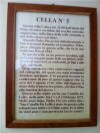
 The sign explains about the original cell #5
and remind that in cell #5 happened the transverberation.
The sign explains about the original cell #5
and remind that in cell #5 happened the transverberation.
Padre Pio's routines
Padre Pio's life in the 52 years he stayed in San Giovanni Rotondo revolved around few yards of space.
Cells
Cell #5
When Padre Pio moved to San Giovanni Rotondo in 1916, he was assigned the cell #5. The room is very small. On the right side there is a bed, with a crucifix on the wall, a nightstand, a trunk for personal things, two chairs, and a case.

 The sign explains about the original cell #5
and remind that in cell #5 happened the transverberation.
The sign explains about the original cell #5
and remind that in cell #5 happened the transverberation.

 Padre Pio's undershirt with blood in the right shoulder area
found and certified by Fra' Modestino when he was ordered to do the
inventory of the cell after Padre Pio's death. Before, little was known about the shoulder wound, related to
Jesus carrying the Cross to the Calvary, in the Passion.
Padre Pio's undershirt with blood in the right shoulder area
found and certified by Fra' Modestino when he was ordered to do the
inventory of the cell after Padre Pio's death. Before, little was known about the shoulder wound, related to
Jesus carrying the Cross to the Calvary, in the Passion.
 Two cloths for the side wound.
Two cloths for the side wound.
 The bed.
The bed.  Window in the cell. On the left there was a chest of drawers and on the right
side nightstand and bed.
Window in the cell. On the left there was a chest of drawers and on the right
side nightstand and bed. On the nightstand there is a buzzer.
On the nightstand there is a buzzer.
In
the original cell are soap, brushes, nail clippers.
Two identical statues of Baby Jesus, but with different color of dress, and more
brushes.
Cell #1
Padre Pio moved to this cell in 1943. The cell #1 is roomier than the #5. The armchair with the green cushion is were Padre Pio died.

 The cell was used by Padre Pio for about
thirty years. There are two windows facing south beyond the vegetable garden of
the convent. One of the windows has sink replacing the old basin with the
pitcher, for washing. From this window Padre Pio used to greet the faithful
below, using his handkerchief.
The cell was used by Padre Pio for about
thirty years. There are two windows facing south beyond the vegetable garden of
the convent. One of the windows has sink replacing the old basin with the
pitcher, for washing. From this window Padre Pio used to greet the faithful
below, using his handkerchief.


 On the side a chest of drawers with
several objects on top, and several images on the wall.
On the side a chest of drawers with
several objects on top, and several images on the wall.
On the left, a little desk. and a kneeler.

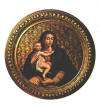 Over the bed
there are two crucifixes, on the wall near the bed there is a framed Deposition
and the intercom box (citofono) to monitor and respond to his needs.
Over the bed
there are two crucifixes, on the wall near the bed there is a framed Deposition
and the intercom box (citofono) to monitor and respond to his needs.
At the foot of the bed there is a painting of the Madonna of Purity, in a very fine artistic wooden frame.
 Padre Pio usually kept his Capuchin habit in bed.
Padre Pio usually kept his Capuchin habit in bed.
 Padre Pio greeted by Fra' Daniele.
Padre Pio greeted by Fra' Daniele.
 Padre Carmelo da San Giovanni in Galdo,
superior of the convent,
checking on Padre Pio sick in bed.
Padre Carmelo da San Giovanni in Galdo,
superior of the convent,
checking on Padre Pio sick in bed.

 Padre Pio used brown fingerless gloves over the wounds of the hands during the
day.
Padre Pio used brown fingerless gloves over the wounds of the hands during the
day.
At night he used white gloves.
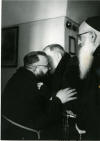
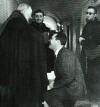


_small.jpg)





 Faithful,
friars, seminarians and bishops outside Padre Pio's cell.
Faithful,
friars, seminarians and bishops outside Padre Pio's cell.
Two St. Mary of the Graces churches
 The
original church.
The
original church.
 The new church on the side of the old church and
convent.
The new church on the side of the old church and
convent.



 The inside of the church of St. Mary of Graces were Padre Pio celebrated mass and confessed
since coming to San Giovanni Rotondo in 1916. The church was consecrated on July
5, 1676.
The inside of the church of St. Mary of Graces were Padre Pio celebrated mass and confessed
since coming to San Giovanni Rotondo in 1916. The church was consecrated on July
5, 1676.
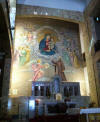
![]()

 The inside of the new St. Mary of the Graces church.
The inside of the new St. Mary of the Graces church.




 The church includes a wide balcony, frequently used by Padre Pio for meditation
and prayer.
The church includes a wide balcony, frequently used by Padre Pio for meditation
and prayer.
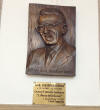 The architect was
Giuseppe Gentile. Work started on July 2, 1956. The church was consecrated on
July 1, 1959.
The architect was
Giuseppe Gentile. Work started on July 2, 1956. The church was consecrated on
July 1, 1959.
Seven Altars

 Main altar of St. Mary of Graces, the original church of the convent, were Padre Pio celebrated mass in special occasions and when the church was full.
Main altar of St. Mary of Graces, the original church of the convent, were Padre Pio celebrated mass in special occasions and when the church was full.
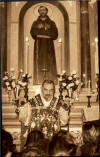

 In the old church of St. Mary of Graces Padre Pio celebrated mass most
frequently at the
altar of St. Francis. Here he is giving the final blessing. This was the moment when
people on the sides of the altar could see through the wound on Padre Pio's
right hand.
In the old church of St. Mary of Graces Padre Pio celebrated mass most
frequently at the
altar of St. Francis. Here he is giving the final blessing. This was the moment when
people on the sides of the altar could see through the wound on Padre Pio's
right hand.
In the third picture there is also a woman holding a camera. Many people realized that when they took pictures of Padre Pio the film came out blank.
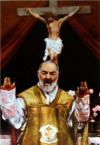
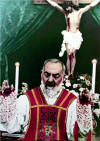
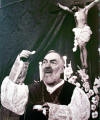
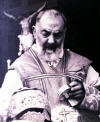

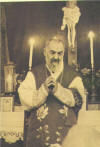 The
third altar were Padre Pio used to say Mass was set on a platform outside the old church, in good weather, to accommodate more
faithful.
The
third altar were Padre Pio used to say Mass was set on a platform outside the old church, in good weather, to accommodate more
faithful.
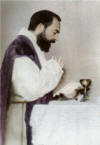
 Padre Pio celebrated mass alone in this chapel in the years 1931-1933, when
severe restrictions by the Holy Office were implemented.
Padre Pio celebrated mass alone in this chapel in the years 1931-1933, when
severe restrictions by the Holy Office were implemented.
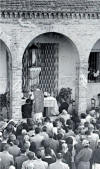

 The
fifth altar was set under the porch of the newly constructed assembly hall. Few
years later the hall was demolished to make room for the new St. Mary of the
Graces church.Padre Pio used to say mass on this location in good weather, to
accommodate the increasing number of the faithful.
The
fifth altar was set under the porch of the newly constructed assembly hall. Few
years later the hall was demolished to make room for the new St. Mary of the
Graces church.Padre Pio used to say mass on this location in good weather, to
accommodate the increasing number of the faithful.

 Padre Pio celebrates mass at the altar set up at the entrance of "Casa Sollievo della Sofferenza"
the day of the grand opening and in other anniversaries.
Padre Pio celebrates mass at the altar set up at the entrance of "Casa Sollievo della Sofferenza"
the day of the grand opening and in other anniversaries.
 The seventh altar were Padre Pio celebrated was at the main altar of the new St. Mary's of the Graces church.
He celebrated at this altar from 1959 until his death.
The seventh altar were Padre Pio celebrated was at the main altar of the new St. Mary's of the Graces church.
He celebrated at this altar from 1959 until his death.
Two Confessionals
 The confessional were Padre Pio confessed the women as it is preserved.
The confessional were Padre Pio confessed the women as it is preserved.
The women went to the confessional located on the left side on St. Mary's church, while the men always confessed in the sacristy of the old church.. The men kneeled on a kneeler, except for a brief period when a confessional box was installed in the sacristy.
 Men waiting to confess to Padre Pio, before a system of reservations was
implemented. Many days Padre Pio confessed for 19 hours.
Men waiting to confess to Padre Pio, before a system of reservations was
implemented. Many days Padre Pio confessed for 19 hours.
![]() Lines of women and men before starting reservations in the '50s.
Lines of women and men before starting reservations in the '50s.

 The office for reservation of the confession of women. There also was one for
men.
The office for reservation of the confession of women. There also was one for
men.

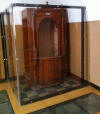



 In the sacristy of the old church a confessional box seen on the left was
temporarily installed in early 1960. Usually the men confessed on the other side of the room.
On time a curtain was added.
In the sacristy of the old church a confessional box seen on the left was
temporarily installed in early 1960. Usually the men confessed on the other side of the room.
On time a curtain was added.


 Padre Pio confessing men.
Padre Pio confessing men. 
 The curtain around the men's
confessional.
The curtain around the men's
confessional.
Two prayer spots: choir and balcony
Choir
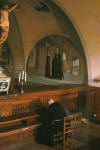
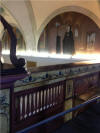
 Padre Pio prayed in the original old choir, near the
parapet
overlooking the church of St. Mary of the Graces. On the arched wall to his
right there is the fresco painting of Saint Veronica Giuliani. Veronica had the
crown of thorns in 1694, and five the stigmata on her body in 1697.
Padre Pio prayed in the original old choir, near the
parapet
overlooking the church of St. Mary of the Graces. On the arched wall to his
right there is the fresco painting of Saint Veronica Giuliani. Veronica had the
crown of thorns in 1694, and five the stigmata on her body in 1697.
 The choir seen from the nave of the church below.
The choir seen from the nave of the church below.

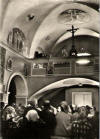 Padre Pio from his prayer spot could see the nave of the
church below, were people stayed in prayer. When Padre Pio concluded
praying, people below were on the lookout, and stood up, looking in his
direction, to be blessed.
Padre Pio from his prayer spot could see the nave of the
church below, were people stayed in prayer. When Padre Pio concluded
praying, people below were on the lookout, and stood up, looking in his
direction, to be blessed.

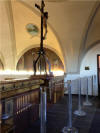 The
prayer spot as
it has been remodeled, is at the right side of the Crucifix.
The
prayer spot as
it has been remodeled, is at the right side of the Crucifix.

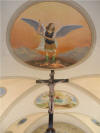
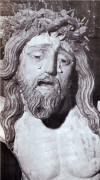
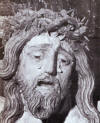 At the center of the choir there is a large crucifix. The
crucifix came alive in 1918 and gave the stigmata to Padre Pio.
At the center of the choir there is a large crucifix. The
crucifix came alive in 1918 and gave the stigmata to Padre Pio.
On the ceiling there is a painting of St. Michael defeating the devil.
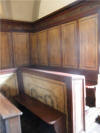
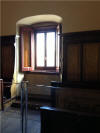
 The right and left side of the choir, with the benches for the friars, as it has
been remodeled. The natural light comes from the window where Padre Pio used to
stand to bless the pilgrims in the square below.
The right and left side of the choir, with the benches for the friars, as it has
been remodeled. The natural light comes from the window where Padre Pio used to
stand to bless the pilgrims in the square below.
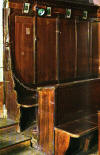


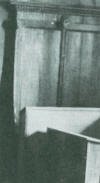
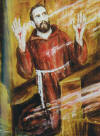 On the back of the choir and on the left side of it, there were the benches for
the friars. Padre Pio was kneeling on the bench of the left side when he
received the wounds. The flower, the sign and the painting indicate the spot.
On the back of the choir and on the left side of it, there were the benches for
the friars. Padre Pio was kneeling on the bench of the left side when he
received the wounds. The flower, the sign and the painting indicate the spot.
Balcony
 Padre Pio in prayer in the center back of the balcony facing the main altar of
the new St. Mary of Graces church.. Fra'
Daniele is with him.
Padre Pio in prayer in the center back of the balcony facing the main altar of
the new St. Mary of Graces church.. Fra'
Daniele is with him.



 On the balcony (matroneo in Italian) of the new
church.
On the balcony (matroneo in Italian) of the new
church.
 Padre Pio walking with the friars.
Padre Pio walking with the friars.

 At the bottom of the U shaped balcony.
At the bottom of the U shaped balcony.
 When Padre Pio was on the balcony he could look at the mosaic of the Madonna.
When he walked to reach his prayer spot he could also see the nave of the
church below, were people were staying in prayer. When Padre Pio concluded
praying, people below were on the lookout, and stood up, looking in his
direction, to be blessed.
When Padre Pio was on the balcony he could look at the mosaic of the Madonna.
When he walked to reach his prayer spot he could also see the nave of the
church below, were people were staying in prayer. When Padre Pio concluded
praying, people below were on the lookout, and stood up, looking in his
direction, to be blessed.
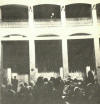 Padre Pio in the balcony, and the faithful below waiting for the blessing. The
same as in the old church.
Padre Pio in the balcony, and the faithful below waiting for the blessing. The
same as in the old church.
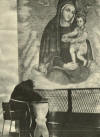
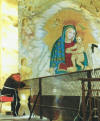 Padre Pio praying, facing the mosaic of the Madonna of the Graces.
Padre Pio praying, facing the mosaic of the Madonna of the Graces.
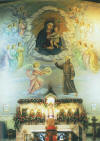
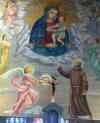 When Padre Pio was proclaimed saint, his image was added to the
mosaic.
When Padre Pio was proclaimed saint, his image was added to the
mosaic.
Sacristy

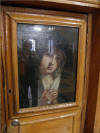
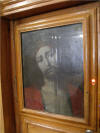

 The
old sacristy as it has been preserved.
The
old sacristy as it has been preserved.
 Padre Pio at the counter in the new sacristy preparing to celebrate a High Mass.
Padre Pio at the counter in the new sacristy preparing to celebrate a High Mass.


 The new sacristy.
The new sacristy. For a period Padre Pio had to go unhelped.
For a period Padre Pio had to go unhelped.



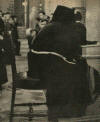 Praying in the new sacristy after mass.
Praying in the new sacristy after mass.
People greeting Padre Pio before he leaves the new sacristy after mass.
Hallway


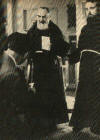 From the sacristy were Padre Pio confessed the men, after the confession he had
to walk to the door of the convent. Before he could reach the entrance, people
were amassed to have a chance to talk to him, get a blessing, kiss the hand or
just see him up close.
From the sacristy were Padre Pio confessed the men, after the confession he had
to walk to the door of the convent. Before he could reach the entrance, people
were amassed to have a chance to talk to him, get a blessing, kiss the hand or
just see him up close.
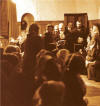
 In the wall of
the old sacristy, in a niche, there was a water dispenser were Padre Pio washed his fingers before putting on the liturgical vestments. The container
has been preserved in the same spot.
In the wall of
the old sacristy, in a niche, there was a water dispenser were Padre Pio washed his fingers before putting on the liturgical vestments. The container
has been preserved in the same spot.
St. Francis Hall









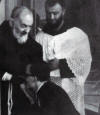
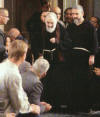 When the St. Francis Hall was built, it was the major gathering spot for men to
meet Padre Pio when he had to go from his room to the new church. Since it was
in the cloistered area, only men were allowed in. The large room was given the name from the
lively fresco of
St. Francis painted by the local artist Antonio Ciccone in 1959.
When the St. Francis Hall was built, it was the major gathering spot for men to
meet Padre Pio when he had to go from his room to the new church. Since it was
in the cloistered area, only men were allowed in. The large room was given the name from the
lively fresco of
St. Francis painted by the local artist Antonio Ciccone in 1959.
Medals and rosaries
Padre Pio used to bless rosaries and other religious object presented by the visitors. He used to give away blessed medals upon request. The last two pictures show American GI's receiving blessed medals.
Blessing from the window "finestrella"

 Padre Pio waived is handkerchief to the crowd in the square below, after praying
the "The angel of God" at noon, with the faithful from the window in the choir.
The window is located above the main entrance to the original church of St. Mary
of the Graces.
Padre Pio waived is handkerchief to the crowd in the square below, after praying
the "The angel of God" at noon, with the faithful from the window in the choir.
The window is located above the main entrance to the original church of St. Mary
of the Graces.
Two Refectories
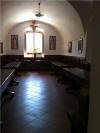 The original refectory. Padre Pio's place was on the
right. It is marked by a sign and a picture of him.
The original refectory. Padre Pio's place was on the
right. It is marked by a sign and a picture of him.
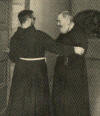
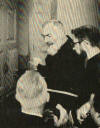


 Near the entrance to the refectory of the friars.
Near the entrance to the refectory of the friars.
Padre Pio's intake of food was a remarkable exercise in temperance. He never had breakfast, seldom had dinner, and frequently joined the friars at lunch time. He ate no more then an ounce or two of food, once per day. His favorite food: broccoli rabe (broccoli di rape in italian) (vruoccl e rap in Neapolitan, his native language). He also had at times a sip of beer. Everything was in minuscule quantities, and shared with the other friars.
 Testing the food of the workers at the hospital, during construction.
Testing the food of the workers at the hospital, during construction.
Lancet arch
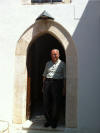

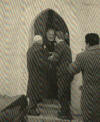

The
side door to the convent from the garden has a characteristic laced arch.
The space in front of it was used to park carriages, and later cars. Some days
Padre Pio went to the threshold to bless carriages or cars.
Garden
In good weather Padre Pio spent about thirty minutes every late afternoon to relax with friars and friends in the backyard garden of the convent. When he was not able to do it anymore because of health reason he spent time on the enclosed veranda.
Veranda rattan
 In this picture Padre Pio is with Giovanni Bardazzi from Prato. it must have been winter time
on the veranda. The friar is preparing to put a throw on Padre Pio's lap, while
he deals with a stuffy nose and rests the feet on the kneeler.
In this picture Padre Pio is with Giovanni Bardazzi from Prato. it must have been winter time
on the veranda. The friar is preparing to put a throw on Padre Pio's lap, while
he deals with a stuffy nose and rests the feet on the kneeler.
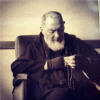

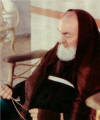
 Here he is on the same spot. Padre Pio is sitting on the same armchair, on the
veranda, praying the rosary. Talking to the now
Blessed Giacomo Alberione.
Here he is on the same spot. Padre Pio is sitting on the same armchair, on the
veranda, praying the rosary. Talking to the now
Blessed Giacomo Alberione.




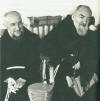
 In warmer months the rattan wicker set took over. Here
padre Pio is sitting on a rattan armchair, talking to Aldo Moro,
John McCaffery, Padre Alessio (glasses), Padre Alessandro, and McCaffery; Padre
Clemente; Padre Alessandro da Ripabottoni, and Fra' Daniele Natale.
In warmer months the rattan wicker set took over. Here
padre Pio is sitting on a rattan armchair, talking to Aldo Moro,
John McCaffery, Padre Alessio (glasses), Padre Alessandro, and McCaffery; Padre
Clemente; Padre Alessandro da Ripabottoni, and Fra' Daniele Natale.
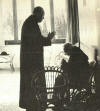 Padre Pio is blessed by a bishop.
Padre Pio is blessed by a bishop.
 A child asking Padre Pio if he really is Padre Pio.
A child asking Padre Pio if he really is Padre Pio.
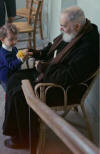 Padre Pio with a child.
Padre Pio with a child.
 The rattan set has been preserved.
The rattan set has been preserved.
Elm circular bench

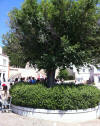
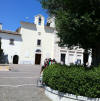

 The elm tree with the circular bench has been there for
several decades. Padre Pio too used to sit there talking to visitors in the
early days. Until Padre Pio was alive, the large bush that now prevents people from
sitting and resting, was not there.
The elm tree with the circular bench has been there for
several decades. Padre Pio too used to sit there talking to visitors in the
early days. Until Padre Pio was alive, the large bush that now prevents people from
sitting and resting, was not there.
Plays
 In 1916 there was no construction on the side of the church.
In 1916 there was no construction on the side of the church.



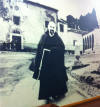
 Later
a wing was added with a large room uses for meetings and also to produce
plays, with the intent to raise money for the construction of the hospital.
The wing was removed to make room for the new church of St. Mary of the
Graces. The production of the plays continued in the conference room of the new
hospital "Casa Sollievo." The subjects of the plays were episodes from the
Bible, or the lives of the saints. The plays were written and produced by Cleonice Morcaldi. The rehearsals were held at the home of Mary Pyle. Several
ladies helped in making the costumes, including Elide Bellomo who was a
seamstress by trade.
Later
a wing was added with a large room uses for meetings and also to produce
plays, with the intent to raise money for the construction of the hospital.
The wing was removed to make room for the new church of St. Mary of the
Graces. The production of the plays continued in the conference room of the new
hospital "Casa Sollievo." The subjects of the plays were episodes from the
Bible, or the lives of the saints. The plays were written and produced by Cleonice Morcaldi. The rehearsals were held at the home of Mary Pyle. Several
ladies helped in making the costumes, including Elide Bellomo who was a
seamstress by trade.

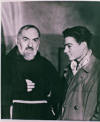 The photographer Elia Stelluto asks Padre Pio during a play if he can take a picture of him with the flash. The
camera and flash are of huge size, seen on the lower right. The straw chair were
Padre Pio's arms rest must have been in use for many years.
The photographer Elia Stelluto asks Padre Pio during a play if he can take a picture of him with the flash. The
camera and flash are of huge size, seen on the lower right. The straw chair were
Padre Pio's arms rest must have been in use for many years.
 Padre Pio enjoyed watching the plays.
Padre Pio enjoyed watching the plays.
Voting
When padre Pio went to vote downtown, it was like a ticker parade. The car in the picture taking Padre Pio to the ballots, a FIAT millequattro, has been preserved by the owner.
Grooming

 Haircut by Vincenzo Miniscalchi.
Haircut by Vincenzo Miniscalchi.
 Padre Alessio tinkering with the beard.
Padre Alessio tinkering with the beard.
Padre Pio with his brother Michele. Note the swollen feet, even with special custom sandals.
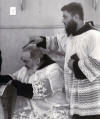 Final touch before the evening function in church.
Final touch before the evening function in church.
Terrace
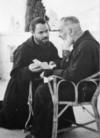
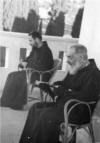 Padre
Pio prays the breviary on the terrace, assisted by fra' Daniele.
Padre
Pio prays the breviary on the terrace, assisted by fra' Daniele.
Letters

 Padre Pio received quite a bit of mail
from all over the world. At one time several friars worked on the
correspondence. Padre Pio used to pass by the mailroom, give a blessing to
the letters, and outline answers to those singled out for significance.
Padre Pio received quite a bit of mail
from all over the world. At one time several friars worked on the
correspondence. Padre Pio used to pass by the mailroom, give a blessing to
the letters, and outline answers to those singled out for significance.
 Nicola Cocomozzi, employee of the post office in San
Giovanni Rotondo, brought for several years to Padre Pio the mail items that
needed his signature. Padre Pio blessed Nicola's wedding, and also baptized his child.
Nicola Cocomozzi, employee of the post office in San
Giovanni Rotondo, brought for several years to Padre Pio the mail items that
needed his signature. Padre Pio blessed Nicola's wedding, and also baptized his child.
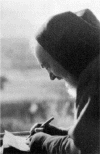
 Padre Pio writing a letter while sitting in fine balance on the tip of the chair.
Padre Pio writing a letter while sitting in fine balance on the tip of the chair.
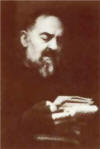
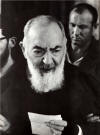
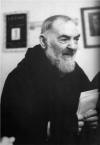 When Padre Pio met people, frequently he was given letters.
When Padre Pio met people, frequently he was given letters.
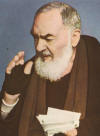
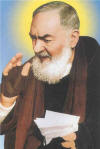 The
official
Vatican image for the proclamation of sainthood of Padre Pio shows him holding
letters.
The
official
Vatican image for the proclamation of sainthood of Padre Pio shows him holding
letters.
Wheelchair

 Last few months of life Padre Pio made the same routes, but in a wheelchair.
Last few months of life Padre Pio made the same routes, but in a wheelchair.
100 facial expressions of Padre Pio